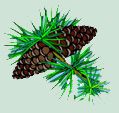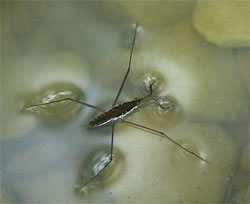 Seed Dispersal: Wind, water, fruit, attaching, caching and...FIRE!
Seed Dispersal: Wind, water, fruit, attaching, caching and...FIRE!
 Seed Dispersal: Wind, water, fruit, attaching, caching and...FIRE!
Seed Dispersal: Wind, water, fruit, attaching, caching and...FIRE!
To survive fire some plants have adaptive traits that allow them
to reproduce or regenerate.
The way a plant stores its seeds and disperses them is an example
of a fire adaptive strategy. The intensity of the fire is crucial
to the seeds dispersal. Also important is how often the fires
occur. A number of species of pine have cones that only open
after a fire. These are called serotinus. Heat triggers the
seed dispersal mechanism.
Bishop pines have cones that are held closed by a resin sensitive to high temperatures. These cones will not open to release their seeds until a critical temperature is reached. Some plants may not come into flower for many years and if the fires are too frequent, the plant is destroyed before it has had the chance to produce seeds. In some cases if fires are frequent and do not reach the correct temperature, the species will be killed and the seeds not dispersed (the right heat is crucial to the seeds dispersal mechanism). Some species store their seeds in the soil until a fire reaches the right heat for germination to be triggered. Again if the fires are low intensity the parent plant may die but germination not triggered.
Let's Ponder: Do you know of an area locally in which
seed dispersal was successful because of fire?
(Hint:Which branch of the bird family benefits from burned trees?
 Water Striders
Water Striders
With scissorlike movements of their long, spindly legs, water striders can skitter clear across a pond with amazing speed. For years, scientists have considered the feat a minor miracle. Now a team of researchers from the Massachusetts Institute of Technology has solved the problem. Led by mathematician John W. M. Bush, the scientists used high-speed film to record baby water striders skating across an aquarium. By dropping ink into the tank, they were able to follow any water movements created by the insects' legs. They report in the journal Nature that water striders use their legs like crew teams use oars. The insects' legs create dimples in the air/water interface that they can push against to move, much the way sprinters push off from starting blocks. The dip of each leg creates a mini water vortex in each dimple. Surface tension--the same force that pushes grease into circular droplets atop a bowl of soup--is enough to keep the bugs afloat at all times.
 Baccharis pilularis, or "Coyote Brush"
Baccharis pilularis, or "Coyote Brush"
Coyote brush has bright, yellowish-green, slightly toothed, round leaves. The leaves are arranged alternately on the stem. Coyote brush is dioecious, producing male and female flowers on different plants. The flowers are small and creamy white. The fruit is a tiny seed which hangs off a tuft of hair called a pappus. This time of year, the pappus catches the wind and flies, aiding the plant to spread its seeds. On a windy day in the Fall, coyote bushes look as if they are snowing! Coyote brush is common all over California, from coastal bluffs to oak woodlands to disturbed roadside areas. In the Laguna, it is found under forests and oak woodlands, even in some wetland areas. Coast Miwok have heated coyote brush leaves and applied them to swellings. Some indigenous tribes have used limbs of coyote brush for building houses and for making arrow foreshafts. Coyote brush has been used as a fire retardant. Coyote brush become resinous (sticky) and fragrant on hot summer days. The fragrant oils are distasteful to browsers and may serve to protect the plant from predation. Much maligned and frequently cleared from land all over Sonoma County, Coyote brush is one of the last nectar producing plants of the season, providing nourishment to over 240 species of insects and birds!
Let's Ponder: Visit and appreciate a blooming coyote bush this week, on a sunny, warm day. Notice the amazing number of bees, insects and flies that are feeding on the blossoms and seeds.